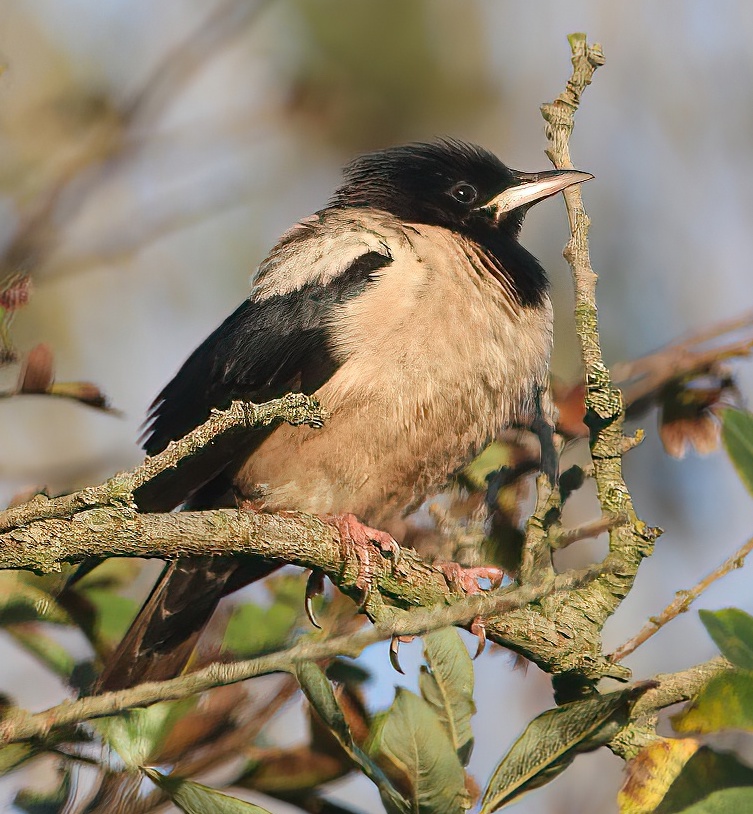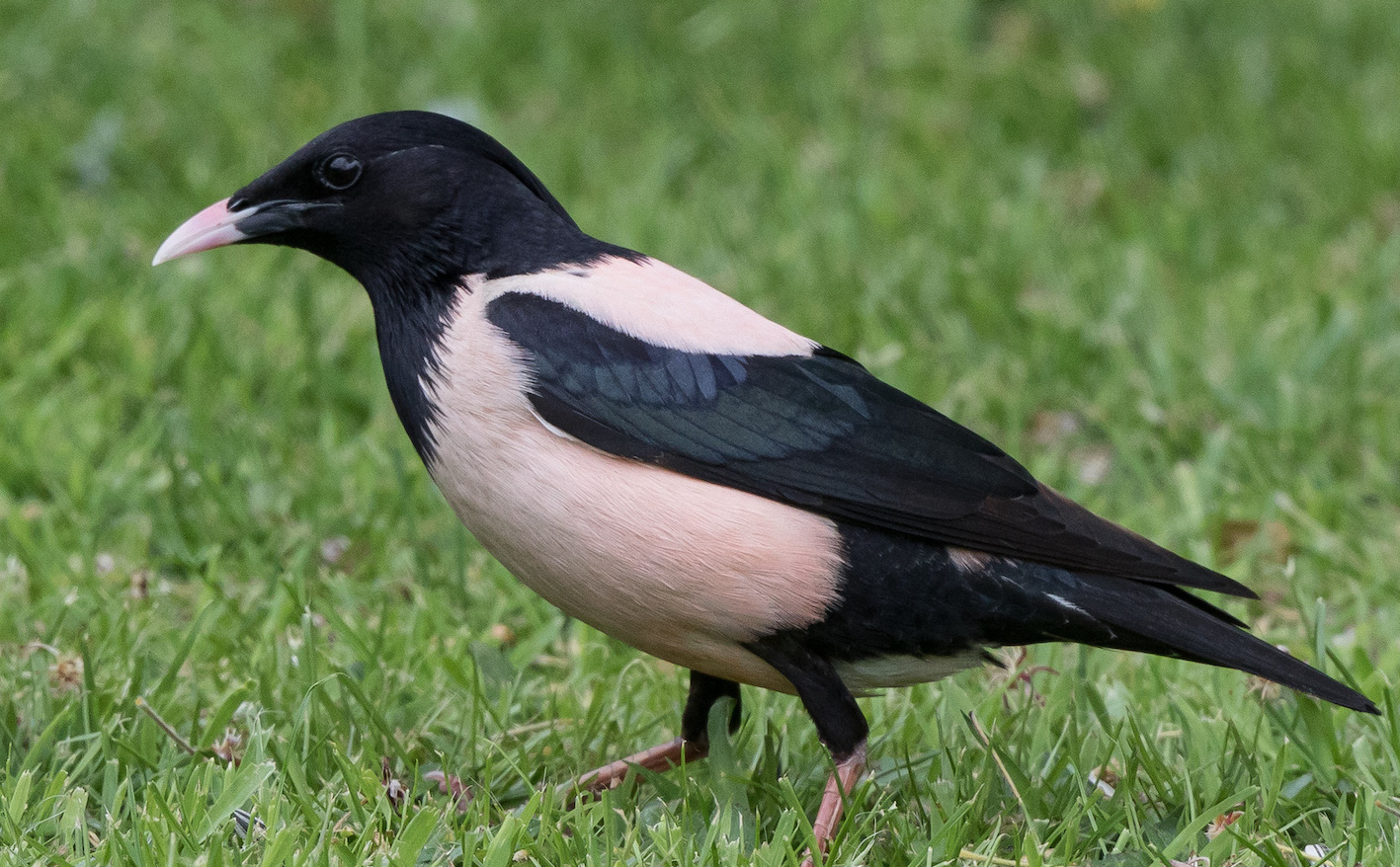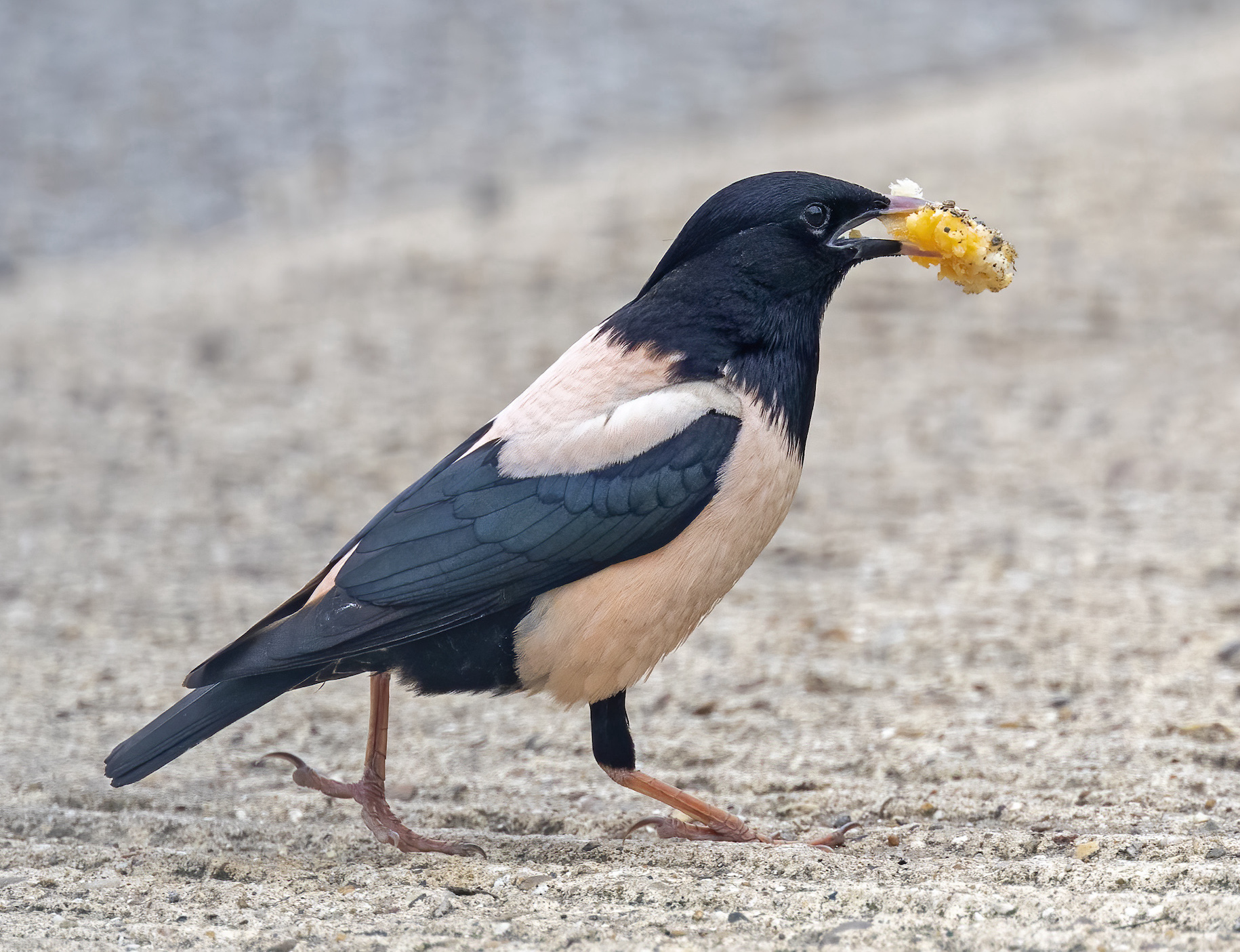Rosy Starling Sturnus roseus
Rare. Eastern and south-eastern Europe, south-west Asia.



Rosy Starlings: left, Anderby Creek October 10th 2014 (Phil Hyde); centre, Saltfleetby June 7th 2018 (John Clarkson);
right Mablethorpe July 2020 (Graham Catley).
This gaudy visitor from the east first fell victim to someone’s gun reportedly prior to 1783, near Grantham (no specific date) and another was recorded in the county in July 1818 (no locality) when Morris (1851) stated that "In Northumberland a small flock was seen near Bamburgh Castle in July 1818, in company with Starlings; one about the same time near Newcastle; and two others were shot near Alnwick. In Lincolnshire also, and in Durham" Almost a century later, an adult male was seen in Cleethorpes August 1st,1909 feeding on some late cherries in a garden at Cleethorpes. The bird remained near the cherry-trees all day, and was present early on the following morning, after which it disappeared. It was very wary, and no signs of captivity were seen (Suggitt, 1909). Others were seen in the autumns of 1932 and 1947. A 1CY bird wintered in Skegness December 1955-April 1956, during which time it was trapped. A 1CY bird was trapped at Wainfleet October 1973 and a decade later a 2CY bird was present in Market Deeping, often near the fish and chip shop, February-March 1983. Two more turned up in the 1980s and just one in the 1990s. There then followed a run of 22 records 2000-2018 bringing the total to 32 in all up to 2019. Given the long stays of several of these birds, records have accrued in every month of the year. The spring arrival dates covered May 6th- June 28th. The main autumn arrival period covers August 23rd-November 24th, although the November-December records may refer to birds having arrived earlier in the autumn.
There have been periodic invasions of Rosy Starlings into Britain, the most recently in 2002 (182), 2018 (115) and 2020 (200+); more than 1500 were recorded in France in 2020 and around 20 pairs bred in a colony in the Alpes-de-Haute-Provence department. Whether this will continue, and with an increased number of migrants into the county, remains to be seen.
| Site | First date | Last date | Count | Notes |
| Grantham | 1783 | - | 1 | No specific date, shot. |
| Lincolnshire, no specific site | July 1818 | - | 1 | Mentioned by F.O. Morris in A history of British birds, vol 6. |
| Cleethorpes | 01/08/1909 | 03/08/1909 | 1 | Adult feeding on cherries in a private garden. |
| North Cotes | 10/09/1932 | - | 1 | Adult, feeding with a small flock of Starlings. |
| Holton le Clay | 29/08/1947 | - | 1 | Adult, observer had a brief view before it disappeared into private gardens and an orchard |
| Skegness | 11/12/1955 | 08/04/1956 | 1 | 1CY wintered, also trapped during it's stay. |
| Wainfleet | 18/10/1973 | - | 1 | 1CY |
| Market Deeping | mid-February | 08/03/1983 | 1 | Adult |
| Sleaford | 21/06/1984 | - | 1 | Adult |
| South Witham | 23/08/1987 | - | 1 | 1CY |
| Chapel St. Leonards | 18/06/1995 | 24/06/1995 | 1 | Adult |
| Donna Nook | 21/09/2000 | - | 1 | 1CY |
| Louth | 13/06/2001 | 15/06/2001 | 1 | Adult male |
| Chapel St. Leonards | 30/09/2001 | - | 1 | 1CY |
| Marshchapel | 14/06/2002 | 16/06/2002 | 1 | Adult |
| Tetney | 16/06/2002 | - | 1 | Same as Marshchapel bird |
| Cranwell | 22/11/2002 | 21/03/2003 | 1 | 1CY, fed regularly in private gardens. |
| Boston | 24/05/2003 | - | 1 | Adult, in private garden. |
| Gibraltar Point NNR | 13/10/2003 | 14/10/2003 | 1 | 1CY |
| Freiston Shore | 21/05/2004 | 23/05/2004 | 1 | Adult |
| Donna Nook | 10/10/2004 | - | 1 | 1CY |
| Hemingby | 16/12/2004 | 1 | 1CY, reportedly present since mid-October but no other dates available. | |
| Hemingby | 01/02/2005 | 18/04/2005 | 1 | |
| North Somercotes | 11/11/2005 | 18/11/2005 | 1 | 1CY, trapped and ringed on 17/11/2005 |
| Ashby de la Launde | 24/11/2007 | - | 1 | Adult |
| Mablethorpe | 28/06/2008 | 30/06/2008 | 1 | Adult, in private garden. |
| Messingham | 27/10/2008 | - | 1 | Adult with c. 2000 Common Starlings. |
| Frampton Marsh | 20/06/2012 | 25/06/2012 | 1 | Adult |
| Anderby Creek | 07/10/2014 | 13/10/2014 | 1 | Adult, in private garden. |
| Stallingborough | 06/05/2015 | - | 1 | Adult, in private garden. |
| Donna Nook | 07/10/2016 | 13/10/2016 | 1 | 1CY |
| Saltfleetby St Clement | 07/06/2018 | 08/07/2018 | 1 | Adult, in private garden. |
| Deeping St Nicholas | 11/06/2018 | - | 1 | Adult |
| Winteringham Haven | 01/06/2020 | - | 1 | Adult, in private garden. |
| Skegness | 09/09/2020 | - | 1 | Adult, in private garden. |
| Mablethorpe | 10/07/2020 | - | 1 | Adult male, in private garden. |
| Holbeach Clough | 01/06/2021 | - | 1 | Adult |
| Huttoft | 03/06/2021 | - | 1 | Adult |
| Gibraltar Point NNR | 03/06/2021 | - | 1 | Adult |
| Blyton | 06/06/2021 | 07/06/2021 | 1 | Adult |
| Donna Nook NNR | 04/09/2023 | - | 1 | 1CY |
Finder’s report: Rosy Starling at Market Deeping, mid-February 1983: eighth county record.
by D. Hursthouse
Note: this account is based on the original BBRC submission and some correspondence between the county recorder at the time, Graham Catley (GPC), and a local lady, Mrs B. Melsom. It was the first record since 1973 and the first we have on file. The BBRC report for 1983 noted 16 records bringing the British total since 1950 to 146 at the time.
Circumstances
A local lady, Mrs B. Melsom, first saw the bird on February 17th, 1983, and she was struck by the ‘large pink patches’ under the wings. It was feeding on scraps from the local fish and chip shop. Later, in conversation with a friend she said that the bird had also been seen in mid-January (no written confirmation of this was received though). Mrs Melsom kindly sent a map of the bird’s location to the county recorder (GPC) and birders arrived from March 4th to view the bird. The description was supplied by Dave Hursthouse who watched the bird on and off for two hours on March 4th, using 10x40 binoculars and a 20-45x60 telescope. There were a few showers early on a cloudy morning, brightening later and with a light breeze and good visibility. The bird was again seen feeding on scraps of food in the waste bins and on the roof tops of out-buildings of the local fish and chip shop.
Description
General appearance – same size and shape as Starling with slightly longer legs and tail.
Head and crown – conspicuous blackish crest, bluish-black sheen on head nape, throat and upper breast giving the bird a hooded appearance. Throat feathers pale-tipped and very faint pale tips to the crown feathers. Indistinct pale irregular supercilium after the eye.
Upperparts – mantle pinky with brownish smudges; scapulars pinky; lower back, rump and uppertail coverts uniform pink. Wings showed pinky-brown alula and lesser coverts; median coverts, outermost feathers brownish, tipped pale, inners blackish tipped pale; greater coverts blackish tipped pale except outer two feathers; tertials blackish with pale narrow edges more noticeable on tips; secondaries brownish with pale narrow edges; primaries blackish with narrow pale edges.
Tail – square-ended tail, blackish with narrow pale edgings turning white at the tips. Tail looked longer than Starling.
Underparts – breast, belly, and flanks uniform pink. Sides of rump and undertail coverts blackish with broad white edges.
Bare parts – bill slightly decurved, blunter-looking than Starling and without the dagger-like appearance. Basal two thirds of lower mandible straw coloured, with the remaining third towards the tip pale flesh. Straw-coloured a third of the way along the cutting edge at the base of the upper mandible, with the remainder pale flesh. Legs and feet flesh; eyes black.
References
Bird Guides (2021). Europe set for another Rosy Starling influx. https://www.birdguides.com/news/europe-set-for-another-rosy-starling-influx/
Morris, F. O. (1851). Rose-coloured Pastor in History of British birds, vol 3: 145-148. Groombridge and Sons, London.
Suggitte, W. E. (1909). Rose-coloured Starling in Lincolnshire. British Birds 3 (4): 126.

